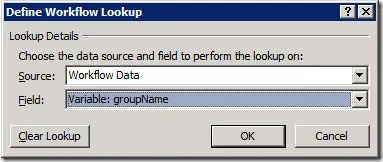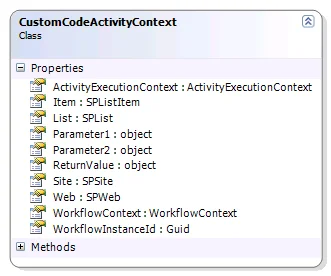Even though we have only recently released the Muhimbi Workflow Power Pack for SharePoint, we are already getting good feedback from users. Most of the questions we get are already covered in the User Guide, which is why we have decided to republish the user guide as a series of blog postings.
A quick introduction In case you are not familiar with the product: The Muhimbi Workflow Power Pack for SharePoint allows custom C# or VB.NET code to be embedded in SharePoint Designer Workflows without the need to resort to complex Visual Studio based workflows, the development of bespoke Workflow Activities or long development cycles.
The following Blog postings are part of this User Guide series:
Language Features (this article): Discusses the script like syntax, the generic workflow action and condition, passing parameters, returning values from a workflow and using the MyWorkflow property.
Embedding .net code in a Workflow Condition: Provides a number of examples of how to use the Evaluate Custom Code condition to carry out basic as well as complex conditional tasks.
Embedding .net code in a Workflow Action: Contains a number of examples of how to use the Execute Custom Code to basically carry out any action you can think of in a SharePoint Designer Workflow.
Creating Custom Methods: Shows how to create your own methods in your scripts in order to keep the code organised and easy to maintain.
Script Like Syntax
To allow code to be entered in an easy fashion, without needing to worry about namespaces, class or method names, the WPP takes a script like approach. In essence the person designing the workflow can just enter a single line of code and the WPP will make sure it is wrapped in the appropriate class.
Even though the traditional structure of a typical C# or VB.net file is not used, it is still possible to add shortcuts to namespaces by adding Using (c#) or Imports (VB) statements to the top of the code.
A simple C# code sample looks as follows:
Note that in order to use System.XML, a reference will need to be added in Central Admin. For details see the Administration Guide
Workflow Action Structure
When adding a new Execute Custom Code action to a workflow you are presented with the following workflow sentence.
The fields are as follows.
Field
Type
Description
this code
Text
The C# or VB.net code to execute.
Language
C# or VB
The language the code is written in.
parameter 1
Object
An optional parameter to pass to the workflow.
parameter 2
Object
Another optional parameter to pass to the workflow.
this variable
Object
An optional workflow parameter to fill with the result.
Enter an optional comment
Text
An optional summary of what the code does.
Workflow Condition structure
When adding an Evaluate Custom Code Condition to a workflow, you are presented with the following.
The fields are as follows.
Field
Type
Description
this code
Text
The C# or VB.net code to execute.
Language
C# or VB
The language the code is written in.
parameter 1
Object
An optional parameter to pass to the condition.
parameter 2
Object
Another optional parameter to pass to the condition.
Enter an optional comment
Text
An optional summary of what the code does.
A condition should always evaluate to either True or False.
Passing values and Parameters
Workflow parameters and other values can be passed to the custom code in a number of ways.
Parameter 1 & 2: Use the Parameter 1 & 2 variables to pass a constant, workflow variable or any other kind of Workflow Lookup value. Note that these values are passed as type Object and may need to be cast into the correct data type in your code.
The Parameter1 and Parameter2 values can be accessed from the custom code using the MyWorkflow variable. For details see Using the MyWorkflow section below.
Embedding Workflow Lookup variables: Workflow Actions allow lookup variables to be directly embedded into the source code using the Add Lookup button.
At runtime all lookup variables are placed into the code as text, so please make sure that the generated syntax is still valid.
For example, the following code will not execute correctly:
String name = [%Variable: firstName%];
As this may result in the following code:
String name = John;
To solve this problem, add quotes around the variable as follows:
String name = "[%Variable: firstName%]";
Which will result in to following, syntactically correct, code:
String name = "John";
Note that SharePoint does not allow Workflow Lookups to be defined in the code for Custom Conditions as these are handled differently inside the workflow execution engine.
Returning Values
Variables or result values can be returned from your custom code by using the MyWorkflow.ReturnValue property.
Returning values using the return statement is not supported.
Using the MyWorkflow property
When developing workflows you frequently need access to data related to the workflow. To make accessing this data easy you can access the MyWorkflow property from your own code.
MyWorkflow underlying type
The MyWorkflow property has the following fields.
Field
Type
Description
ActivityExecutionContext
Represents the execution environment of an Activity. This class selectively exposes workflow runtime capabilities and services to individual activities.
Item
Reference to the item the current workflow is acting on.
List
Reference to the SharePoint list the current item is located in.
Parameter1
Object
The first, optional, parameter passed in by the workflow.
Parameter2
Object
The second, optional, parameter passed in by the workflow.
Site
Reference to the site collection the workflow is located in.
Web
SPWeb
Reference to the site the workflow is located in.
WorkflowContext
Reference to the SharePoint workflow Context.
WorkflowInstanceId
Guid
The ID of the current workflow instance.
The following code illustrates how to use some of the MyWorkflow fields from your own code.
This is just an example. Rather than logging to the workflow history from your own code, you could simply pass the ReturnValue into a standard SharePoint Designer Log to History List activity.






